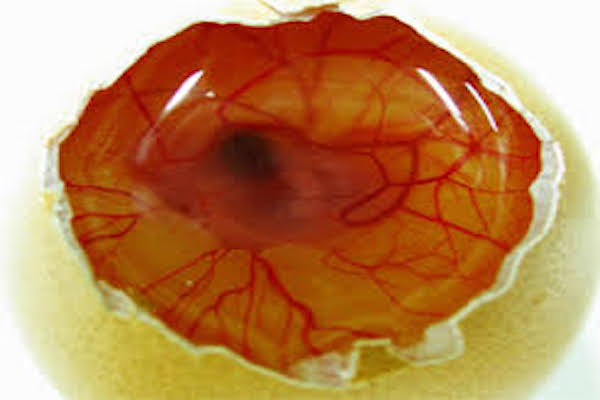Quantification of angiogenic characteristics of Naproxen sodium through chorioallantoic membrane assay
DOI:
https://doi.org/10.15419/bmrat.v4i05.167Keywords:
Angiogenesis, Chorioallantoic membrane, In vivo, Naproxen sodium, BiologyAbstract
Introduction: The aim of the current study was to determine the angiogenic/anti-angiogenic effect of Naproxen Sodium and to determine the effective dose of NapS for angiogenesis.
Method: Fertilized eggs (5days old) of chicken were acquired from a local hatchery. They were incubated at 37oC with humidity of 55-60%. Then, on the 5th day of incubation, a window about 2cm in diameter was created by removing the shell and then the inner shell membrane. It was done under aseptic environment. There were 5 groups designed. Group A was kept as control and was given 0.2ml PBS, group B, C, D, and E were given 0.1ml of 0.086g/100μl, 0.042g/100μl, 0.021g/100μl and 0.011g/100μl of Naproxen Sodium (NapS) respectively. On the sixth day, prepared concentrations of NapS were administered and eggs were again sealed with paraffin film under aseptic conditions. These were placed back in the incubator for next 24 hours. After 24 hours, eggs were taken out from the incubator and images of all groups were made using a DSL camera. The development of blood vessels and other features were observed using Adobe Photoshop version 7.0, then these images were transferred to scan probing image processing (SPIP) software 6.6.2. The diameters of different blood vessels were measured by using expert design software. The parameters include: the diameter and branching system of blood vessels measured as per mm, and categories of blood vessels; i.e., primary, secondary and tertiary blood vessels. Data were analyzed on SPSS statistical software version 22.0 using ANOVA. Dunnett’s test was applied considering P < 0.05 as significant.
Result: Application of Naproxen sodium on chorioallantoic membrane of day six of incubation showed angiogenic effects in high concentration and anti-angiogenic effect in low concentration. Outcomes indicated significant changes in CAM’s design, thinning of primary, secondary and tertiary blood vessels, reduction in surface roughness parameters, and decrease in Abbott curve. Conclusion: The substantial quantities of Naproxen sodium use locally may exhibit anti-angiogenic activity in the same manner those seen in vitro and explain its clinical efficacy.
References
Bergers, G., and Benjamin, L.E. (2003). Tumorigenesis and the angiogenic switch. Nature reviews cancer 3, 401-410.
Blacher, S., Devy, L., Hlushchuk, R., Larger, E., Lamandé, N., Burri, P., Corvol, P., Djonov, V., Foidart, J.-M., and Noël, A. (2011). Quantification of angiogenesis in the chicken chorioallantoic membrane (CAM). Image Analysis & Stereology 24, 169-180.
Griffioen, A.W., and Molema, G. (2000). Angiogenesis: potentials for pharmacologic intervention in the treatment of cancer, cardiovascular diseases, and chronic inflammation. Pharmacological reviews 52, 237-268.
Hertig, A.T. (1935). Angiogenesis in the early human chorion and in the primary placenta of the macaque monkey. Contrib Embryol 25, 39-81.
Hussain, I., Omer, M.O., Ashraf, M., and Habib-Ur-Rehman (2011). Effect of diclofenac sodium angiogenesis using chorioallantoic membrane (cam) assay. Journal of applied pharmacy, 320-330.
Salas, G.M., and Totaan, E.V. (2015). Selected Philippine Herbal plant extracts as Angiogenesis inhibitors using Chick Chorioallantoic Membrane (CAM) assay. International Research Journal of Biological Sciences, 28-32.
Tufan, A.C., and Satiroglu-Tufan, N.L. (2005). The chick embryo chorioallantoic membrane as a model system for the study of tumor angiogenesis, invasion and development of anti-angiogenic agents. Current cancer drug targets 5, 249-266.

Downloads
Published
Issue
Section
License
Copyright The Author(s) 2017. This article is published with open access by BioMedPress. This article is distributed under the terms of the Creative Commons Attribution License (CC-BY 4.0) which permits any use, distribution, and reproduction in any medium, provided the original author(s) and the source are credited.
